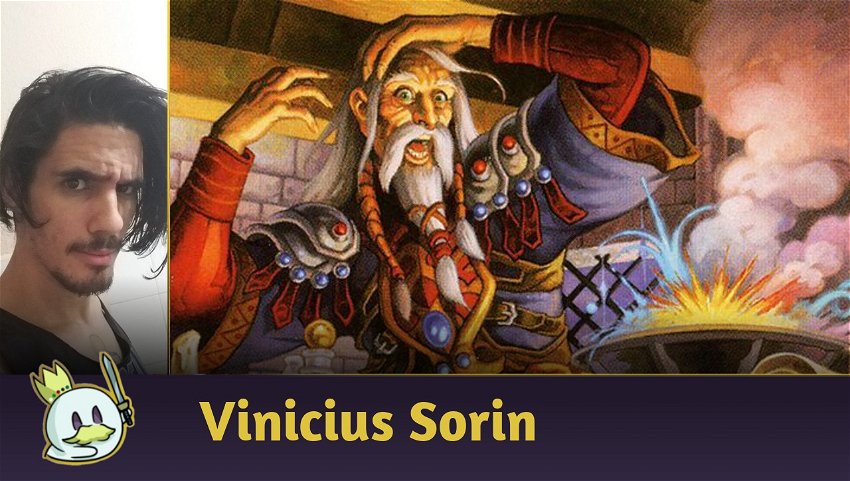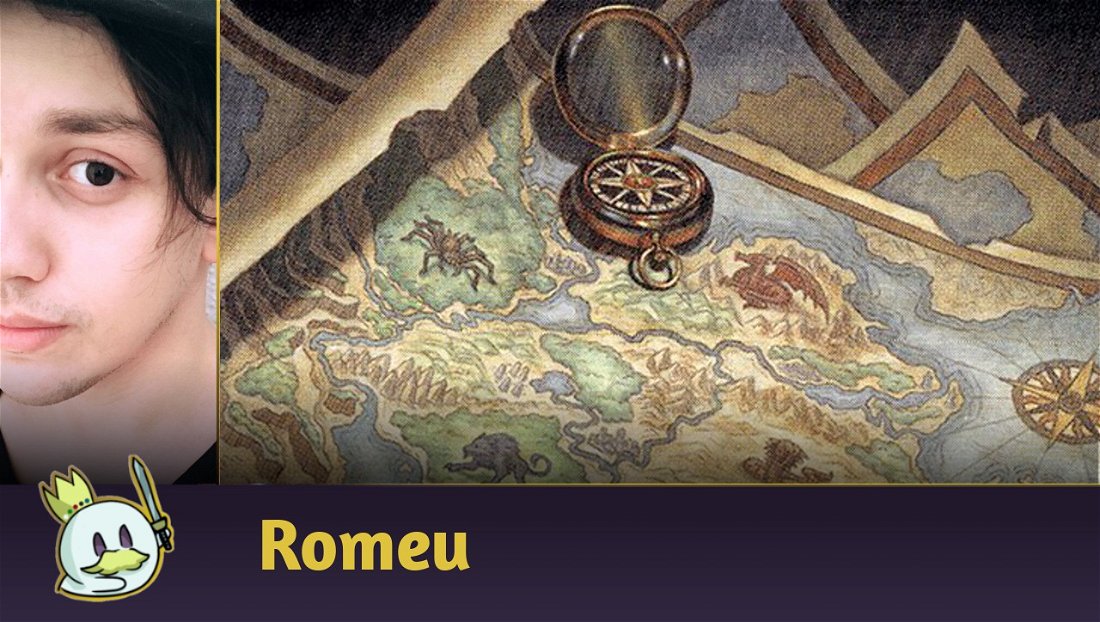Hello, readers.
After some time covering the new Kamigawa set, it's time to resume our Commander Deckbuilding series. In the past episodes, I took care to let you know of concepts and terms that will help you to better understand what we are going to discuss from now on. Today you will have the first contact with some of these concepts, but you will end the reading with a simple and objective idea of how to build a Commander deck from scratch.
Ad
In this episode, we're going to bring up the functions that a Commander deck can/needs to contemplate to be playable, in addition to the necessary amount of cards it needs for each of them.
Card Functions
The immense variety of cards existing in Magic encompasses an infinite range of diverse effects, from the most generic to the most specific and unique. Card effects and abilities, however, can often be framed in well-known roles, which will have a defined purpose in a deck.
The most relevant and basic functions of the Commander format are described below. Many others may exist, depending on a deck's theme or strategy, but these are the ones you'll find in virtually every Commander deck you'll ever see.
Lands

This one is self-explanatory. Lands constitute the bulk of what we call manabase, and they're necessary for you to—you guessed it—generate mana to play your spells and pay costs. Every deck obviously requires enough of them so that you start the game with something like 3 lands in your starting hand and keep playing one land per turn, at least during the early game.
It is worth noticing that in this role, only lands that are capable of generating mana are considered. Cards like Maze of Ith or Thawing Glaciers shouldn't count in your manabase, despite being lands.
Acceleration

In a Magic game, a player is expected to be able to maintain a progressive ability to generate mana over the course of turns. That is: on the 1st turn they have one mana available, on the 2nd turn they have two mana, and so on. This progression is commonly referred to as the Mana Curve and mainly considers the fact that a player can normally play 1 land per turn. However, in Commander the use of heavy spells (with a mana value of 5 or more) is quite common, as is the need/desire to be able to cast them as early as possible.
Acceleration cards have the utility function of advancing your mana curve, giving you access to more mana sooner. In this category, we have examples of classic cards like Cultivate, Caged Sun and many others.
Among the most used are artifacts that generate mana — or mana rocks — such as Sol Ring and Arcane Signet — and ramps, which are cards that search for lands and put them into play — like Cultivate or Solemn Simulacrum. However, there are other types of acceleration, such as creatures that generate mana (Birds of Paradise), cost reducers (Goblin Electromancer), rituals (Dark Ritual), among others.
The vast majority of Commander decks use accelerators, as they imply an incremental advantage that is universal. Furthermore, even if your deck doesn't have many high-cost spells and theoretically doesn't "need" mana boosters, you should consider that your opponents will use these types of cards and if you simply decide not to use them, you may fall behind the curve.
Draws

Ad
Draws are utility effects that make you replenish your hand, thus keeping you access to new features and allowing you to keep “making stuff”, especially during the later stages of the game.
As a general rule, an effective draw effect makes you have more cards in your hand than you had before it resolved. For example, a player who has 2 cards in his hand and casts a Brainstorm, will still have 2 cards after the spell resolves, so there was no resource gain, only its replacement (Brainstorm itself).
A player in the same situation, who instead casts Ambition's Cost, will end the effect with 4 cards in hand, thus increasing their number of cards. Even so, cards like Brainstorm can still be useful in certain contexts, even if they are not effective draws, but theoretically the ideal for a deck is to have cards that will actually provide additional resources to keep you going for as much of a match as possible (which in Commander's case can take a while).
Interactions

Interactions are utility effects used to deal with your opponents' threats, either neutralizing them or killing them for good. The most common and used type of interactions are removals, which are usually destruction or exile effects like Feed the Swarm or Path to Exile, for example. However, there are many other types of interactions, from counterspells (Counterspell), bounces (Capsize) and pacifying effects (Song of the Dryads) to effects that tap creatures or prevent them from attacking.
Interactions can basically be divided into two categories: targeted and sweepers. As the names suggest, targeted interactions affect few targets, frequently one or two at most; whereas sweepers affect several at the same time (Damnation and Cyclonic Rift are classic examples). The latter are useful in cases where things get out of hand and require a drastic solution.
Interactions are essential in any deck, as you are likely to need them a lot at various times in a multiplayer game. In most games you're going to play, preventing your opponents from playing their game is just as important as you playing yours.
Recursions

Recursions are cards that allow you to reuse resources that have already been “spent”. Most are effects that return cards from the graveyard, such as Reanimate or Mystic Retrieval, but they may not be limited to just that.
Effects that return in-game permanents to the hand (Temur Sabertooth) and blink effects (Restoration Angel) may also be considered. In a general context, recursions take on a function similar to drawing cards, giving you access to more resources and in some cases even providing an effective card advantage.
However, while widely valued by many Commander deckbuilders, recursions are not as essential or mandatory as draw spells.
Tutors

Ad
Tutors are special utility effects that allow you to search your library for a specific card. Demonic Tutor, Fabricate and Idyllic Tutor are very objective examples of tutors. These cards are very powerful, as they allow you to ignore the elements of randomness and inconsistency inherent in playing a 99-card singleton deck. Tutors are used as wild cards, and can be used to fulfill any role that a card it may seek is capable of performing. However, their most widespread use is in facilitating combos, as they are the easiest way to pull specific pieces from a library during play.
Overall, tutors aren't as mandatory as interactions or draws are; but they tend to be incredibly useful cards in any deck, even if they aren't necessarily essential.
Bombs

Bombs are high-impact cards designed to put pressure on and sometimes unbalance the game in your favor. They are valuable resources at times in the game where you need to decide things. Because of their power, they are usually heavy spells and that you will only be able to use in later stages of the game when you have a lot of mana.
The most common examples of bombs are large creatures such as Sun Titan, Craterhoof Behemoth and Blightsteel Colossus, but a bomb can also be any other type of card that has an impactful effect on the game, such as Rise of the Dark Realms, Omniscience or Overwhelming Stampede.
The need for bombs in a Commander deck is debatable and varies widely. Many decks can play perfectly without them, so you can't say bombs are as mandatory as removals or draws. But the fact is that most decks use them as their main winconditions.
Templates
Templates are pre-defined formulas that establish an ideal minimum number of cards for each role that a deck “should have”. A template works like a "cake recipe", where a deck's slots are divided into separate "packages" according to the cards' functions.
Each package has a suggested number of slots that should only be filled by cards with that role. Essentially, important functions in theory should have more slots, while less important ones can be leaner.
Here's a template that I like to use as a starting point when building my decks:
1 Commander
36 Lands
8 Acceleration
8 Draw Spells
12 Interactions (8 targeted, 4 sweepers)
37 Free Slots
Note that the “Free Slots” package is the biggest of all, as it will be made up of the cards most geared to the theme(s) of your deck. If you're building an elf deck, most of them will be here. If it's a graveyard-based deck, fill some of these spaces with reanimate cards, and so it goes.
You can also subdivide this package into smaller packs, with cards of a specific function. As in the following example where we have a Muldrotha Reanimate deck:
1 Muldrotha, the Gravetide (Commander)
36 Lands
8 Acceleration
8 Draw Spells
12 Interactions (8 targeted, 4 sweepers)
8 Graveyard Fillers (Stinkweed Imp, Grisly Salvage)
Ad
8 Graveyard Recursions (World Shaper, Animate Dead)
4 Tutors (Entomb, Buried Alive)
7 Sac Outlets (Viscera Seer, Sylvan Safekeeper)
10 Bombs (Toxrill, the Corrosive, Sheoldred, Whispering One)
Customizing a Template
The template above is a formula created based on my experience playing with my group, but it's obviously far from failures. Depending on the deck proposal, some slots are rearranged to meet specific strategy needs. A control deck with few creatures, for example, would use more sweepers. A very heavy commander would require more mana acceleration cards. At the same time, your group's demands may not be the same as mine. You may feel more comfortable using more than 8 draw cards; or 4 sweepers is too much for you.
Anyway, the ideal thing is that you create your own template, based on your play style and what you believe a deck needs to have to be minimally functional. Customizing a template is simple: just rearrange the slots according to what you think is best for the deck you are building. It's important to keep in mind just two factors before creating a template:
The 8 Rule If you're not certain how many cards are needed to fill a package, consider that 8 is a reasonable number to start with. This amount gives an average percentage for a card with that role to have an average presence in the deck... not too much, not too little. If a certain card function is essential to your strategy, consider dedicating more than 8 slots to it. If it's unimportant, or you only need them at certain times in the game, use less than 8.
Ordinary Functions: Some card functions are essential for virtually any deck to function minimally, regardless of its strategy or theme. These are the Mana ramp, the interactions and the draw spells. Avoid using less than 8 cards in each of these packages in your deck, however that may be.
Another mandatory thing is the land. As a general rule of thumb, don't run less than 34 lands in your deck, as a number below that will certainly be insufficient, and you'll have many chances to get mana screwed. An exception to this rule are decks that runs a lot of acceleration (12 or more), in which case you can use fewer lands. Likewise, a deck with many lands (38 or more) can generate a surplus, causing you to draw more lands than you want (mana flood).
Gameplay: The Best Method Ever
Theories and formulas help us get a head start, but the best way to build a satisfying deck is to play with it. The first tests with a newly built deck are the ultimate workshop for understanding what works and what doesn't. Identifying the deck's flaws and hits during games will make you more clear about what you should adjust, until you get to a final version.
Templates are a great way to start from scratch, but it's the empirical gameplay experience that will give you the most important information on how to make it reach the potential you want.
Conclusion
I hope I have helped you with this content, which despite being comprehensive is still just the tip of the iceberg. I look forward to your feedback in the comments and would like to know which template you would use to build your own Commander decks.
Ad
In the coming episodes, we'll delve deeper into each of the card functions covered in this article. Until then!








— Comments0
Be the first to comment